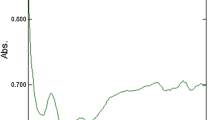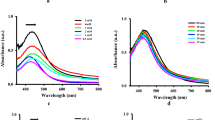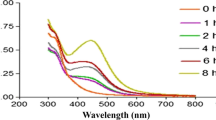Abstract
Mosquito vectors (Diptera: Culicidae) are responsible for transmission of serious diseases worldwide. Mosquito control is being enhanced in many areas, but there are significant challenges, including increasing resistance to insecticides and lack of alternative, cost-effective, and eco-friendly products. To deal with these crucial issues, recent emphasis has been placed on plant materials with mosquitocidal properties. Furthermore, cancers figure among the leading causes of morbidity and mortality worldwide, with approximately 14 million new cases and 8.2 million cancer-related deaths in 2012. It is expected that annual cancer cases will rise from 14 million in 2012 to 22 million within the next two decades. Nanotechnology is a promising field of research and is expected to give major innovation impulses in a variety of industrial sectors. In this study, we synthesized titanium dioxide (TiO2) nanoparticles using the hydrothermal method. Nanoparticles were subjected to different analysis including UV–Vis spectrophotometry, Fourier transform infrared spectroscopy (FTIR), X-ray diffraction (XRD), field emission scanning electron microscopy (FESEM), zeta potential, and energy-dispersive spectrometric (EDX). The synthesized TiO2 nanoparticles exhibited dose-dependent cytotoxicity against human breast cancer cells (MCF-7) and normal breast epithelial cells (HBL-100). After 24-h incubation, the inhibitory concentrations (IC50) were found to be 60 and 80 μg/mL on MCF-7 and normal HBL-100 cells, respectively. Induction of apoptosis was evidenced by Acridine Orange (AO)/ethidium bromide (EtBr) and 4′,6-diamidino-2-phenylindole dihydrochloride (DAPI) staining. In larvicidal and pupicidal experiments conducted against the primary dengue mosquito Aedes aegypti, LC50 values of nanoparticles were 4.02 ppm (larva I), 4.962 ppm (larva II), 5.671 ppm (larva III), 6.485 ppm (larva IV), and 7.527 ppm (pupa). Overall, our results suggested that TiO2 nanoparticles may be considered as a safe tool to build newer and safer mosquitocides and chemotherapeutic agents with little systemic toxicity.










Similar content being viewed by others
References
Amer A, Mehlhorn H (2006a) Larvicidal effects of various essential oils against Aedes, Anopheles, and Culex larvae (Diptera, Culicidae). Parasitol Res 99:466–472
Amer A, Mehlhorn H (2006b) Repellency effect of forty-one essential oils against Aedes, Anopheles and Culex mosquitoes. Parasitol Res 99:478–490
Amer A, Mehlhorn H (2006c) Persistency of larvicidal effects of plant oil extracts under different storage conditions. Parasitol Res 99:473–477
Amer A, Mehlhorn H (2006d) The sensilla of Aedes and Anopheles mosquitoes and their importance in repellency. Parasitol Res 99:491–499
Benelli G (2015) Research in mosquito control: current challenges for a brighter future. Parasitol Res 114:2801–2805
Benelli G (2016) Plant-mediated biosynthesis of nanoparticles as an emerging tool against mosquitoes of medical and veterinary importance: a review. Parasitol Res. doi:10.1007/s00436-015-4800-9
Benelli G, Murugan K, Panneerselvam C, Madhiyazhagan P, Conti B, Nicoletti M (2015) Old ingredients for a new recipe? Neem cake, a low-cost botanical by-product in the fight against mosquito-borne diseases. Parasitol Res 114:391–397
Clinical and Laboratory Standards Institute (2006) M7-A7 methods for dilution antimicrobial susceptibility tests for bacteria that grow aerobically; approved standard, 7th edn. Clinical and Laboratory Standards Institute, Wayne, PA
Dinesh D, Murugan K, Madhiyazhagan P, Panneerselvam C, Nicoletti M, Jiang W, Benelli G, Chandramohan B, Suresh U (2015) Mosquitocidal and antibacterial activity of green-synthesized silver nanoparticles from Aloe vera extracts: towards an effective tool against the malaria vector Anopheles stephensi? Parasitol Res 114:1519–1529
Donaldson K, Stone V, Borm PJ, Jimenez LA, Gilmour PS (2003) Oxidative stress and calcium signaling in the adverse effects of environmental particles (PM10). Free Radic Biol Med 34:1369–1382
Elangovan K, Elumalai D, Anupriya S, Shenbhagaraman R, Kaleena PK, Murugesan K (2015) Phyto mediated biogenic synthesis of silver nanoparticles using leaf extract of Andrographis echioides and its bio-efficacy on anticancer and antibacterial activities. J Photochem Photobiol B: Biol 151:118–124
Finney DJ (1971) Probit analysis. Cambridge University Press, London
Furukawa F, Doi Y, Suguro M, Morita O, Kuwahara H, Masunaga T (2011) Lake of skin carcinogenicity of topically applied titanium dioxide nanoparticles in the mouse. Food Chem Toxicol 49:744–749
Gopinath P, Gogoi SK, Sunpui P, Pual A, Chattupadhyay A, Ghosh SS (2010) Signaling gene cascade in silver nanoparticle induced apoptosis. Colloids Surf B 77:240–245
Haghi M, Hekmatafshar M, Janipour MB, Gholizadeh SS, Faraz MK, Sayyadifar F, Ghaedi M (2012) Antibacterial effect of TiO2 nanoparticles on pathogenic strain of E. coli. Int J Adv Biotechnol Res 3:621–662
IARC (2010) Monographs on the evaluation on carcinogenics risks to humans, vol 93. Carbon block, Titanium dioxide and Talc, Lyon, France
Jayaseelan C, Rahuman AA, Roopan SM, Kirthi AV, Venkatesan J, Kim S, Iyappan M, Siva C (2013) Biological approach to synthesize TiO2 nanoparticles using Aeromonas hydrophila and its antibacterial activity. Spectrochim Acta Part A: Mol Biomol Spectrosc 107:82–89
Kovendan K, Murugan K, Shanthakumar SP, Vincent S, Hwang JS (2012) Larvicidal activity of Morinda citrifolia L. (Noni) (Family: Rubiaceae) leaf extract against Anopheles stephensi, Culex quinquefasciatus, and Aedes aegypti. Parasitol Res 111:1481–1490
Kulkarni M, Mazare A, Gongadze E, Perutkova S, Kralj-Iglic V, Milosev I, Schmuki P, Iglic A and Mozetic M (2015) Titanium nanostructures for biomedical applications. IOB Publishing. Nanotechnology 26. doi: 10.1088/0957-4484/26/6/062002
Lagopati N, Kitsiou PV, Kontos AI, Venieratos P, Kotsopoulou E, Kontos AG, Dionysiou DD, Pispas S, Tsilibary EC, Falaras P (2010) Photo-induced treatment of breast epithelial cancer cells using nanostructured titanium dioxide solution. J Photoch Photobiol A 214:215–223
Long TC, Saleh N, Tilton RD, Lowry GV, Veronesi B (2006) Titanium dioxide (P25) produces reactive oxygen species in immortalized brain microglia (BV2): implications for nanoparticle neurotoxicity. Environ Sci Technol 40:4346–4352
Long TC, Tajuba J, Sama P, Saleh N, Swartz C et al (2007) Nanosize titanium dioxide stimulates reactive oxygen species in brain microglia and damages neurons in vitro. Environ Health Perspect 115:1631–1637
Marquis BJ, Love SA, Braun KL, Haynes CL (2009) Analytical methods to assess nanoparticle toxicity. Analyst 134:425–439
Murugan K, Benelli G, Ayyappan S, Dinesh D, Panneerselvam C, Nicoletti M, Hwang JS, Mahesh Kumar P, Subramaniam J, Suresh U (2015a) Toxicity of seaweed-synthesized silver nanoparticles against the filariasis vector Culex quinquefasciatus and its impact on predation efficiency of the cyclopoid crustacean Mesocyclops longisetus. Parasitol Res 114:2243–2253
Murugan K, Benelli G, Panneerselvam C, Subramaniam J, Jeyalalitha T, Dinesh D, Nicoletti M, Hwang JS, Suresh U, Madhiyazhagan P (2015b) Cymbopogon citratus-synthesized gold nanoparticles boost the predation efficiency of copepod Mesocyclops aspericornis against malaria and dengue mosquitoes. Exp Parasitol 153:129–138
Murugan K, Aruna P, Panneerselvam C, Madhiyazhagan P, Paulpandi M, Subramaniam J, Rajaganesh R, Wei H, Saleh Alsalhi M, Devanesan S, Nicoletti M, Syuhei B, Canale A, Benelli G (2016) Fighting arboviral diseases: low toxicity on mammalian cells, dengue growth inhibition (in vitro) and mosquitocidal activity of Centroceras clavulatum-synthesized silver nanoparticles. Parasitol Res. doi:10.1007/s00436-015-4783-6
Oberdorster G, Oberdorster E, Oberdorster J (2005) Nanotoxicology: an emerging discipline evolving from studies of ultrafine particles. Environ Health Perspect 113:823–839
Olmedo DG, Tasat DR, Guglielmotti MB, Cabrini RL (2005) Effect of titanium dioxide on the oxidative metabolism of alveolar macrophages: an experimental study in rats. J Biomed Mater Res A 73:142–149
Park EJ, Yi J, Chung KH, Ryu DY, Choi J (2008) Oxidative stress and apoptosis induced by titanium dioxide nanoparticles in cultured BEAS-2B cells. Toxicol Lett 180:222–229
Rajakumar G, Abdul Rahuman A, Jayaseelan C, Santhoshkumar T, Marimuthu S, Kamaraj C, Bagavan A, Abduz Zahir A, Vishnu Kirthi A, Elango G, Arora P, Karthikeyan R, Manikandan S, Jose S (2014) Solanum trilobatum extract-mediated synthesis of titanium dioxide nanoparticles to control Pediculus humanus capitis, Hyalomma anatolicum anatolicum and Anopheles subpictus. Parasitol Res 113:469–479
Sanpui P, Chattopadhyay A, Ghosh SS (2011) Induction of apoptosis in cancer cells at low silver nanoparticle concentrations using chitosan nanocarrier. ACS Appl Mater Interf 3:218–228
Shanthi K, Vimala K, Gopi D, Kannan S (2015) Fabrication of pH responsive DOX conjugated PEGylated palladium nanoparticle mediated drug delivery system: an in vitro and in vivo evaluation. RSC Adv 5:44998–45014
Sohaebuddin SK, Thevenot PT, Baker D, Eaton JW, Tang L (2010) Nanomaterial cytotoxicity is composition, size, and cell type dependent. Part Fibre Toxicol 7:22
Sujitha MV, Kannan S (2013) Green synthesis of gold nanoparticles using Citrus fruits (Citrus limon, Citrus reticulata and Citrus sinensis) aqueous extract and its characterization. Spectrochim Acta Part A: Mol Biomol Spectrosc 102:15–23
Sukirtha R, Priyanka K, Antony JJ, Kamalakkannan S, Thangam R, Gunasekaran P (2012) Cytotoxic effect of green synthesized silver nanoparticles using Melia azedarach against in vitro HeLa cell lines and lymphoma mice model. Process Biochem 47:273–9
Thevenot P, Cho J, Wavhal D, Timmons RB, Tang L (2008) Surface chemistry influences cancer killing effect of TiO2 nanoparticles. Nanomedicine 4:226–236
Velayutham K, Rahuman AA, Rajakumar G, Santhoshkumar T, Marimuthu S, Jayaseelan C, Bagavan A, Kirthi AV, Kamaraj C, Zahir AA, Elango G (2012) Evaluation of Catharanthus roseus leaf extract-mediated biosynthesis of titanium dioxide nanoparticles against Hippobosca maculata and Bovicola ovis. Parasitol Res 111:2329–2337
Vivek R, Kannan S, Achiraman S, Thirumurugan R, Ganesh DS, Krishnan M (2011) Survivin deficiency leads to imparalization of cytokinesis in cancer cells. Asian Pac J Cancer Prev 12:1675–9
Vivek R, Thangam R, Muthuchelian K, Gunasekaran P, Kavery K, Kannan S (2012) Green biosynthesis of silver nanoparticles from Annona squamosa leaf extract and its in vitro cytotoxicity effect on MCF-7 cells. Process Biochem 47:2405–2410
WHO (2012). Dengue and severe dengue: fact sheet no. 117 [webpage on the Internet] Geneva: [cited March 4, 2013]. http://www.who.int/mediacentre/factsheets/fs117/en/index.html
WHO (2015) Cancer. Factsheet N. 297, Geneva
Yang W, Peters JI, Williams RO III (2008) Inhaled nanoparticles—a current review. Int J Pharm 356:239–247
Zhang H, Chen G (2009) Potent antibacterial activities of Ag/Tio2 nanocomposite powders synthesized by a one-potsol-gel method. Environ Sci Technol 934(8):2905–2910
Acknowledgments
The authors would like to thank the financial support rendered by King Saud University, through the Vice Deanship of Research Chairs.
Author information
Authors and Affiliations
Corresponding author
Ethics declarations
All applicable international and national guidelines for the care and use of animals were followed. All procedures performed in studies involving animals were in accordance with the ethical standards of the institution or practice at which the studies were conducted.
Conflict of interest
The authors declare that they have no competing interests. G. Benelli is an Editorial Board Member of Parasitology Research. This does not alter the authors’ adherence to all the Parasitology Research policies on sharing data and materials.
Informed consent
Informed consent was obtained from all individual participants included in the study.
Rights and permissions
About this article
Cite this article
Murugan, K., Dinesh, D., Kavithaa, K. et al. Hydrothermal synthesis of titanium dioxide nanoparticles: mosquitocidal potential and anticancer activity on human breast cancer cells (MCF-7). Parasitol Res 115, 1085–1096 (2016). https://doi.org/10.1007/s00436-015-4838-8
Received:
Accepted:
Published:
Issue Date:
DOI: https://doi.org/10.1007/s00436-015-4838-8




